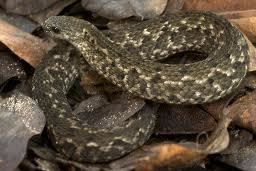Kingdom Animalia Family Viperidae Scientific name Adenorhinos barbouri Higher classification Adenorhinos Order Scaled reptiles | Suborder Serpentes Subfamily Viperinae Phylum Chordata Rank Species | |
 | ||
Genus Adenorhinos
Marx & Rabb, 1965 Similar Proatheris superciliaris, Atheris desaixi, Eristicophis, Atheris hirsuta, Atheris nitschei | ||
Adenorhinos is a monotypic genus created for the venomous viper species, Adenorhinos barbouri, which is a small and exceptionally rare terrestrial species endemic to the Uzungwe and Ukinga mountains of south-central Tanzania in Africa. No subspecies are recognized.
Contents
Etymology
The specific name, barbouri, is in honor of American herpetologist Thomas Barbour.
Description
A. barbouri is a small species reaching only 40 cm (16 in) in total length (body + tail). The head is broad, triangular and distinct from the neck. The snout is short and rounded. The head is covered with small, strongly keeled, imbricate scales. The eyes are prominent; about 1.5 times larger than the distance to the mouth. The nostril is in an extreme forward position and is part of a single nasal scale that touches the preocular scale.
The body is moderately slender, while the tail is relatively short, shorter than in the genus Atheris, and not prehensile. The dorsal scales are arranged in 20-23 rows at midbody, and are strongly keeled, except for those in the outermost rows, which are smooth. Ventral scales 116-122 and rounded. Subcaudals 19-23, single. Anal plate single.
The color pattern consists of a brown to blackish brown ground color with a pair of zigzag stripes that run dorsolaterally from the back of the head to the end of the tail. These stripes may form an irregular chain of darker rhombic blotches down the back. The tail may have a faint, black checkering. The belly color is greenish white to olive.
Common names
Uzungwe viper, Barbour's viper, worm-eating viper, Barbour's short-headed viper, Udzungwa viper, short-headed viper, Uzungwe mountain bush viper.
Geographic range
Its range is extremely limited. It is known only from the Uzungwe and Ukinga mountains of south-central Tanzania.
The type locality is "Dabaga, Uzungwe Mountains, southeast of Iringa, Tanganyika Territory, altitude 6,000 feet (1,800 m)" (= Udzungwe Mountains, Tanzania).
Habitat
A terrestrial species, it is found in bushes and bamboo undergrowth on mountain slopes at 1,800 m (5,900 ft). It would seem that moist forest habitats are preferred, but it has also been found in gardens of tea farms.
Behavior
Little is known about its behavior. It was first thought to be a burrowing species, but this is not likely as it has no obvious morphological adaptations for even a semifossorial life.
Feeding
It is believed that this species specializes in eating slugs, earthworms, and other soft-bodied invertebrates, and possibly also frogs.
Reproduction
This species is apparently oviparous. In February 1930, three females were collected that each contained 10 eggs. The largest egg measured 1.0 cm × 0.6 cm (0.39 in × 0.24 in).
Venom
No information is available regarding the composition of the venom, its toxicity, or the effects of a bite. No cases of envenomation have been recorded. However, because of the very limited distribution, bites are unlikely to occur.
Taxonomy
A. barbouri was previously described as a member of the genus Atheris (bush vipers). It differs morphologically from the Atheris group, but recent research by Lenk et al. (2001) suggests that it is closely related to the sympatric species, Atheris ceratophora, even though it differs morphologically from all other members of the genus Atheris. Future research will show whether A. barbouri should be moved back to Atheris, or that Atheris ceratophora and A. barbouri should form a separate clade.
This species is similar to Montatheris hindii and Proatheris superciliaris, which are also both terrestrial species from monotypic genera, as well as previous members of the Atheris group.
